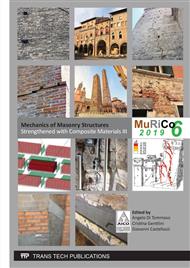[1]
DPCSLP n. 1, 08.01.2019, Linea guida per la idendificazione, la qualificazione ed il controllo di accettazione di compositi fibrorinforzati a matrice inorganica (FRCM) da utilizzarsi per il consolidamento strutturale di costruzioni esistenti.
DOI: 10.3221/igf-esis.12.04
Google Scholar
[2]
C. Faella, E. Martinelli, E. Nigro, S. Paciello, Shear capacity of masonry walls externally strengthened by a cement-based composite material: An experimental campaign, Constr. Build. Mater. 24 (2010) 84-93.
DOI: 10.1016/j.conbuildmat.2009.08.019
Google Scholar
[3]
C. Papanicolaou, T. Triantafillou, M. Lekka, Externally bonded grids as strengthening and seismic retrofitting materials of masonry panels, Constr. Build. Mater. 25 (2011) 504-514.
DOI: 10.1016/j.conbuildmat.2010.07.018
Google Scholar
[4]
F. Parisi, I. Iovinella, A. Balsamo, N. Augenti, A. Prota, In-plane behaviour of tuff masonry strengthened with inorganic matrix–grid composites, Compos. Part B-Eng. 45 (2013) 1657-1666.
DOI: 10.1016/j.compositesb.2012.09.068
Google Scholar
[5]
M. Corradi, A. Borri, G. Castori, R. Sisti, Shear strengthening of wall panels through jacketing with cement mortar reinforced by GFRP grids, Compos. Part B-Eng. 64 (2014) 33-42.
DOI: 10.1016/j.compositesb.2014.03.022
Google Scholar
[6]
N. Ismail, J. M. Ingham, In-plane and out-of-plane testing of unreinforced masonry walls strengthened using polymer textile reinforced mortar, Eng. Struct. 118 (2016) 167-177.
DOI: 10.1016/j.engstruct.2016.03.041
Google Scholar
[7]
Y. Yardim, O. Lalaj, Shear strengthening of unreinforced masonry wall with different fiber reinforced mortar jacketing, Constr. Build. Mater. 102 (2016) 149-154.
DOI: 10.1016/j.conbuildmat.2015.10.095
Google Scholar
[8]
L. A. S. Kouris, T. C. Triantafillou, Design Methods for Strengthening Masonry Buildings Using Textile-Reinforced Mortar, Journal of Composites for Construction 23 (2018), 04018070.
DOI: 10.1061/(asce)cc.1943-5614.0000906
Google Scholar
[9]
M. Shabdin, M. Zargaran, Nader K.A. Attari, Experimental diagonal tension (shear) test of Un-Reinforced Masonry (URM) walls strengthened with textile reinforced mortar (TRM), Constr. Build. Mater. 164 (2018) 704-715.
DOI: 10.1016/j.conbuildmat.2017.12.234
Google Scholar
[10]
X. Wang, C. C. Lam, V. P. Iu, Experimental investigation of in-plane shear behaviour of grey clay brick masonry panels strengthened with SRG, Eng. Struct. 162 (2018) 84-96.
DOI: 10.1016/j.engstruct.2018.02.027
Google Scholar
[11]
M. Basili, G. Marcari, F. Vestroni, Nonlinear analysis of masonry panels strengthened with textile reinforced mortar, Eng. Struct. 113 (2016) 245-258.
DOI: 10.1016/j.engstruct.2016.05.001
Google Scholar
[12]
Garofano, F. Ceroni, M. Pecce, Modelling of the in-plane behaviour of masonry walls strengthened with polymeric grids embedded in cementitious mortar layers, Compos. Part B-Eng. 85 (2016) 243-258.
DOI: 10.1016/j.compositesb.2015.09.005
Google Scholar
[13]
L. Bui, N. Reboul, A. Si Larbi, E. Ferrier, Mechanical in-plane behaviour of masonry walls reinforced by composite materials: Experimental and analytical approaches, J. Compos. Mater. 51 (2017) 4231-4249.
DOI: 10.1177/0021998317701555
Google Scholar
[14]
C.B. De Carvalho Bello, A. Cecchi, E. Meroi, D.V. Oliveira, Experimental and numerical investigations on the behaviour of masonry walls reinforced with an innovative sisal FRCM system, Key Eng. Mater. 747 (2017) 190-195.
DOI: 10.4028/www.scientific.net/kem.747.190
Google Scholar
[15]
G. Mininno, B. Ghiassi, D. V. Oliveira, Modeling of in-plane and out-of-plane performance of TRM-strengthened masonry walls, Key Eng. Mater. 747 (2017) 60-68.
DOI: 10.4028/www.scientific.net/kem.747.60
Google Scholar
[16]
X. Wang, Bahman Ghiassi, Daniel V. Oliveira, C.C. Lam, Modelling the nonlinear behaviour of masonry walls strengthened with textile reinforced mortars, Eng. Struct. 134 (2017) 11-24.
DOI: 10.1016/j.engstruct.2016.12.029
Google Scholar
[17]
L. Pelà, E. Canella, A. Aprile, P. Roca Fabregat. Compression test of masonry core samples extracted from existing brickwork. Constr. Build. Mater., 119 (2016) 230–240.
DOI: 10.1016/j.conbuildmat.2016.05.057
Google Scholar
[18]
L. Pelà, P. Roca, A. Aprile. Combined in-situ and laboratory minor destructive testing of historical mortars. Int. J. Archit. Herit., 12-3 (2018), 334–349.
DOI: 10.1080/15583058.2017.1323247
Google Scholar
[19]
UNI EN 772-1:2015. Methods of test for masonry units - Part 1: Determination of compressive strength.
Google Scholar
[20]
UNI EN 1015-11:2007. Methods of test for mortar for masonry - Part 11: Determination of flexural and compressive strength of hardened mortar.
DOI: 10.3403/01905442u
Google Scholar
[21]
EN 1052-1:2001. Methods of test for masonry - Part 1: Determination of compressive strength.
Google Scholar
[22]
UNI EN 1052-3:2007 Methods of test for masonry Part 3: Determination of initial shear strength.
Google Scholar
[23]
M.B. Ravula, Kolluru V.L. Subramaniam, Cohesive-frictional interface fracture behaviour in soft-brick masonry: experimental investigation and theoretical development, Mater. Struct. (2019) 52:34.
DOI: 10.1617/s11527-019-1333-1
Google Scholar
[24]
ASTM E519: 2007 Standard Test Method for Diagonal Tension (Shear) in Masonry Assemblages.
Google Scholar
[25]
P.B. Lourenço, J.G. Rots, Multisurface interface model for analysis of masonry structures, J. Eng. Mech. 123 (1997) 660-668.
DOI: 10.1061/(asce)0733-9399(1997)123:7(660)
Google Scholar
[26]
K.F. Abdulla, L.S. Cunningham, M. Gillie, Simulating masonry wall behaviour using a simplified micro-model approach, Eng. Struct. 151 (2017) 349-365.
DOI: 10.1016/j.engstruct.2017.08.021
Google Scholar
[27]
D. Gay, S.V. Hoa, S.W. Tsai, Composite materials: design and applications, CRC Press (2003).
Google Scholar
[28]
F. Lebon, S. Dumont, R. Rizzoni, J.C. López-Realpozo, R. Guinovart-Díaz, R. Rodríguez-Ramos, J. Bravo-Castillero, F.J. Sabina, Soft and hard anisotropic interface in composite materials, Compos. Part B-Eng. 90 (2016) 58-68.
DOI: 10.1016/j.compositesb.2015.12.003
Google Scholar
[29]
https://www.sharcnet.ca/Software/Abaqus610/Documentation/docs/v6.10/books/usb/default.htm?startat=pt06ch29s05alm45.html#usb-elm-ecohesivebehavior.
Google Scholar
[30]
P.P. Camanho, C.G. Davila, Mixed-mode decohesion finite elements for the simulation of delamination in composite materials, NASA/TM-2002-211737 (2002).
Google Scholar


